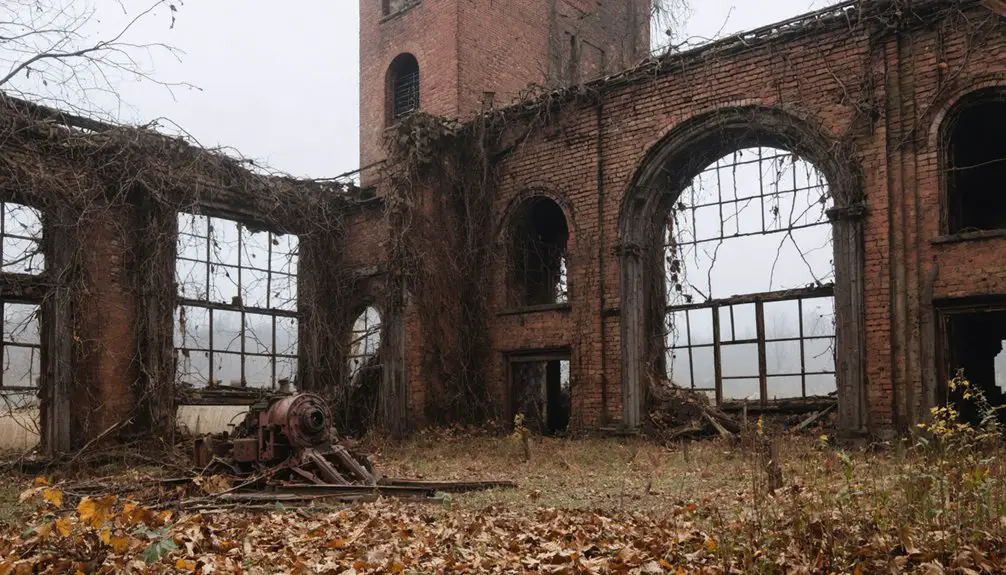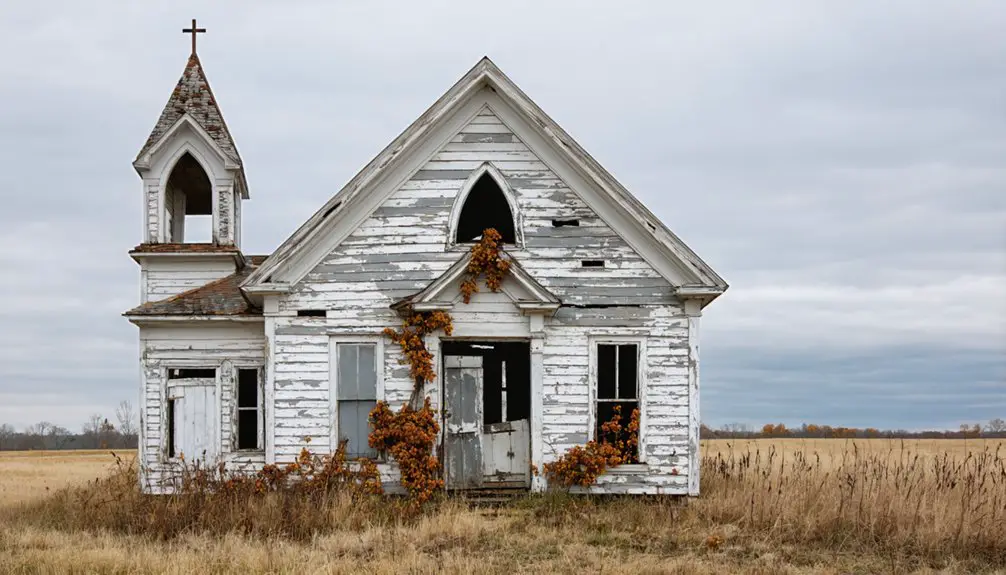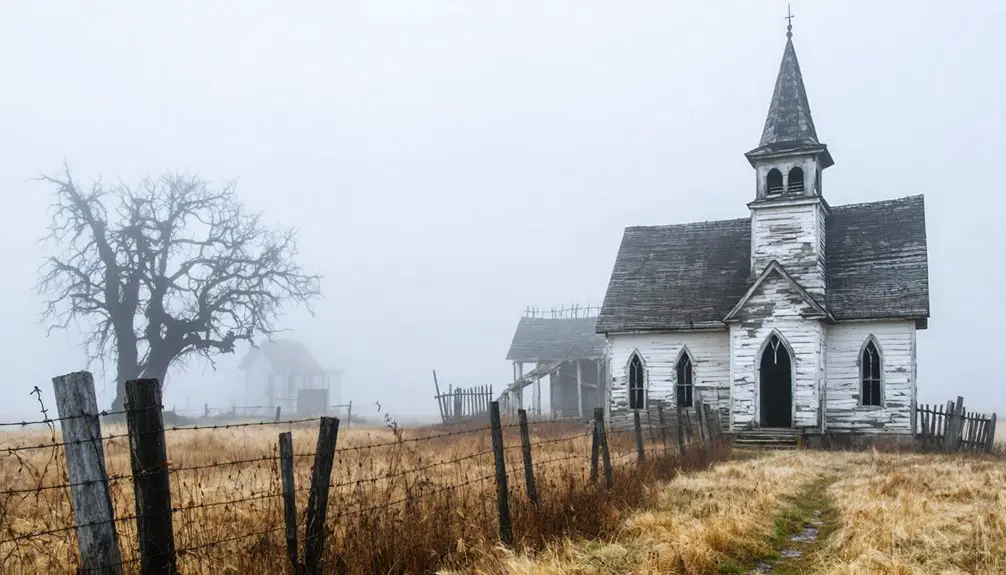You’ll find Hopewell Furnace not in Missouri, but in Pennsylvania, where it stands as America’s last surviving iron plantation. Operating from 1771 to 1883, this meticulously planned industrial complex reached peak production of 933.5 tons of iron in 1861. The site features preserved structures including the original furnace stack, worker housing, and auxiliary buildings. Its transformation from active ironworks to National Historic Site reveals an extraordinary chapter in America’s industrial heritage.
Key Takeaways
- The provided background information refers to Hopewell Furnace National Historic Site in Pennsylvania, not Missouri.
- No historical records indicate the existence of a Hopewell Furnace ghost town in Missouri.
- Missouri had several iron furnaces during the 19th century, but none were named Hopewell Furnace.
- The search appears to confuse two different locations or historical sites.
- The only nationally recognized Hopewell Furnace is the Pennsylvania site, which operated from 1771-1883.
The Historical Significance of Hopewell’s Iron Production
While many early American industrial sites have vanished with time, Hopewell Furnace stands as one of the last surviving “iron plantations” that shaped the nation’s industrial development.
The daily furnace operations required workers to feed 400-800 pounds of iron ore, limestone, and charcoal every thirty minutes to maintain production levels.
You’ll find evidence of its peak iron production reaching 933.5 tons in 1861, demonstrating the site’s significant contribution to America’s industrial growth.
The economic implications of Hopewell’s operations were far-reaching, as its iron supported essential infrastructure projects, including transcontinental railroads.
The furnace experimented with an anthracite furnace in 1849, but high coal costs led to its abandonment.
You can trace the site’s evolution through its technological changes, from water-powered cold-blast processes to later steam-powered operations.
Even in its final years, with iron selling at $99 per ton, Hopewell’s output remained important to manufacturers like A. Whitney & Sons, who used the iron for producing car wheels in Philadelphia.
Daily Life in a 19th Century Industrial Community
Three distinct social spheres shaped daily life in Hopewell Furnace’s 19th-century industrial community: work, family, and communal activities.
You’d find family roles strictly divided by gender, with men and boys handling outdoor labor while women and girls managed household duties. Your daily routine would’ve revolved around demanding physical work, whether in iron production or agricultural tasks. Living without modern conveniences, residents relied on manual methods for all daily tasks. Traditional food preservation methods were essential for survival, as families needed to store provisions through winter months.
You wouldn’t have been alone in your struggles, though. Community events like barn raisings and quilting bees created opportunities for social connection and mutual support.
Communal gatherings brought neighbors together, offering precious moments of connection amid the daily challenges of industrial life.
Through seasonal gatherings and shared labor, you’d build strong bonds with neighbors. Local stores would’ve provided access to both necessities and occasional luxuries, while social clubs and religious organizations helped maintain cultural ties, especially for immigrant workers adapting to industrial town life.
Architectural Remnants and Layout
As you explore Hopewell Furnace’s architectural legacy, you’ll discover a meticulously planned industrial complex centered around its iconic charcoal-fueled iron furnace from 1771-1883.
The site’s layout organization reflects a clear separation between industrial and residential zones, while maintaining practical proximity for workers. The Civilian Conservation Corps performed crucial restoration work in 1938 that helped preserve the site’s historical structures. The Village store journals discovered on site provided vital documentation that prevented the furnace’s demolition.
- The stone and brick furnace stack stands as the heart of the industrial core, with its northeastern face captured in 1930s photographs.
- The restored Ironmaster’s mansion represents refined architectural styles distinct from workers’ quarters.
- Tenant houses feature practical wood floors and dirt hearths for fire safety.
- Auxiliary structures like the spring house, smithy, and wheel house showcase the site’s extensive industrial planning.
You can still trace the water race system that powered the furnace’s bellows, while foundation outlines reveal the positions of numerous support buildings across the 800-acre property.
Environmental Impact and Resource Management
Despite Hopewell Furnace’s essential role in early American industry, its operations left a lasting environmental footprint that you can trace through soil and water contamination studies today.
Industrial heritage comes with environmental costs, as Hopewell Furnace’s centuries-old contamination continues shaping the local ecosystem today.
You’ll find elevated levels of metals like arsenic, copper, and lead in French Creek’s downstream sediments, directly impacting aquatic life and habitat quality.
The furnace’s resource-intensive operations demanded extensive water usage and forest clearing for charcoal production, fundamentally altering the landscape.
While current resource recovery efforts at French Creek State Park focus on ecological restoration, you can still observe the environmental legacy in disturbed benthic communities and contaminated soils.
The most significant impacts stem from mining waste, smelting byproducts, and slag deposits, requiring ongoing monitoring to protect both environmental and human health.
Preservation Efforts and Modern Tourism
Since its designation as a National Historic Site in 1938, Hopewell Furnace’s preservation efforts have transformed an abandoned industrial complex into a meticulously restored historical landmark.
The site’s preservation strategies focus on maintaining authentic 18th and 19th-century structures while creating educational experiences that transport you back to America’s industrial revolution. Under early ownership, the furnace produced 2-3 tons of metal daily at its peak. Located in Berks County, Pennsylvania, the historic site showcases the region’s rich industrial heritage.
- Original buildings, including the furnace, waterwheel, and ironmaster’s house, have been carefully restored using document-based research.
- Tourism challenges include limited public transportation access, requiring visitors to rely on private vehicles.
- Educational programming features interactive demonstrations and interpretive displays showcasing iron-making processes.
- The site maintains a delicate balance between visitor accessibility and protecting fragile historic structures.
You’ll find thoughtfully designed pathways and viewing areas that let you explore while preserving the site’s rural character and historical integrity.
Frequently Asked Questions
What Were the Typical Wages Earned by Workers at Hopewell Furnace?
You’ll find worker compensation varied widely, with skilled founders earning percentage-based wages tied to iron quality, while most workers received store credit rather than direct wages in their wage history.
Are There Any Reported Ghost Sightings or Paranormal Activity at the Site?
You’ll find documented ghost encounters including a ghostly woman in a gown, Sampson Hat’s spirit, and interactive paranormal investigations where spirits communicate through flashlights and leave physical marks on visitors.
How Did Weather Conditions Affect the Furnace’s Daily Operations and Production?
Like a temperamental beast, your furnace’s success hinged on weather’s whims. You’d face operational challenges from wet fuel, temperature swings affecting iron quality, and winds impacting airflow through bellows systems.
Which Specific Products Were Manufactured at Hopewell Furnace for Military Use?
You’ll find their military supplies focused on critical iron production, including cannons for the American Navy, cannon shells, shot for artillery, and various iron components for Continental Army equipment.
What Happened to the Families Who Lived There After the Furnace Closed?
You’ll find families faced significant economic struggles after closure, forcing them to relocate to nearby industrial towns for factory work or move to surrounding agricultural areas to continue farming practices.
References
- https://npshistory.com/publications/hofu/adhi.pdf
- https://en.wikipedia.org/wiki/Hopewell_Furnace_National_Historic_Site
- https://www.youtube.com/watch?v=4LumQv_A8cI
- https://www.nps.gov/hofu/hopewell-furnace-250th-anniversary.htm
- https://npshistory.com/handbooks/historical/8/hh8a.htm
- https://npshistory.com/publications/hofu/index.htm
- https://npshistory.com/handbooks/historical/8/hh8i.htm
- https://www.friendsofhopewellfurn.org/History.html
- https://pubs.usgs.gov/publication/fs20113101
- https://www.makeyourdayhere.com/Events-Attractions/Historic-Sites/Missouri-Town-Living-History-Museum/History



